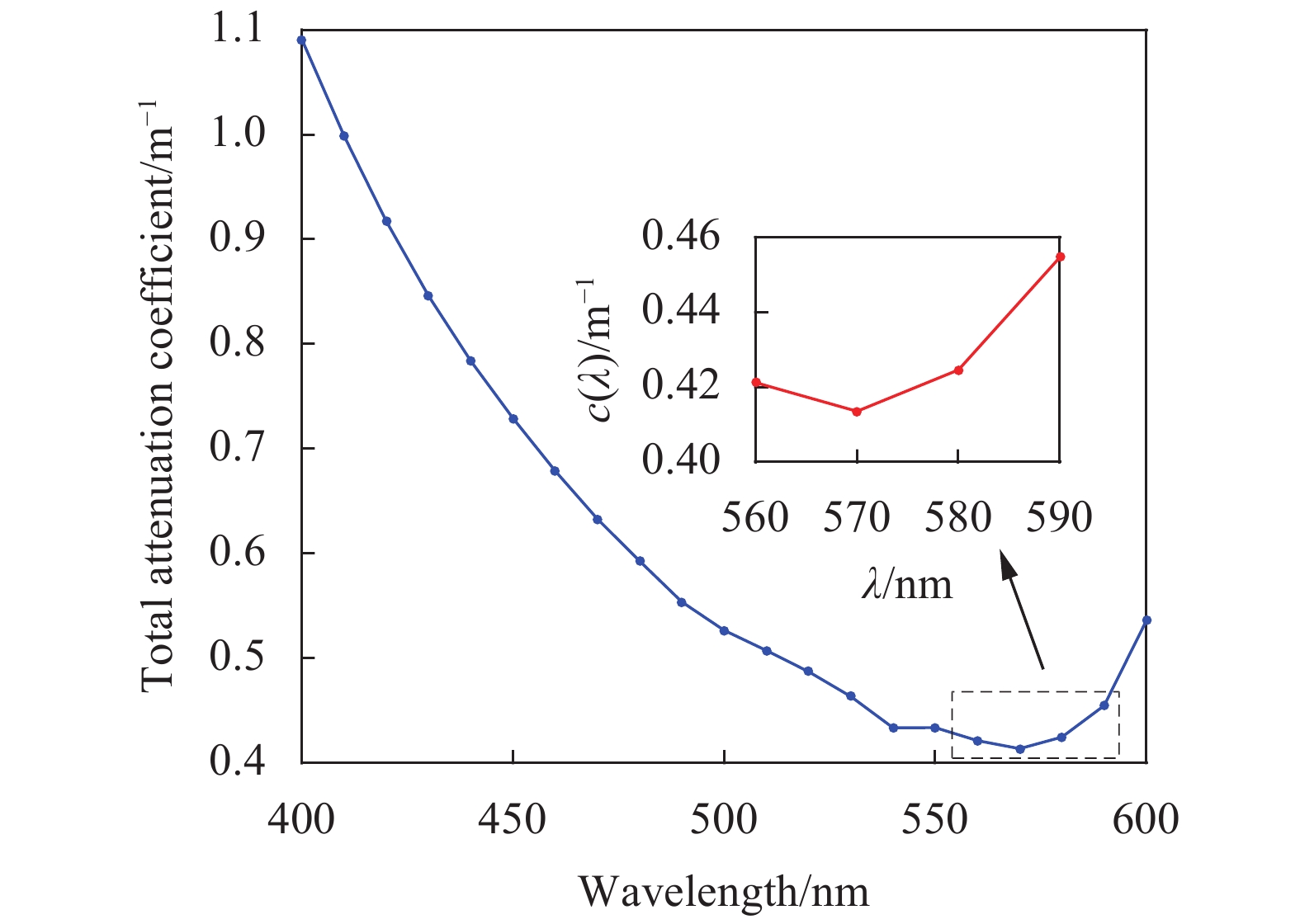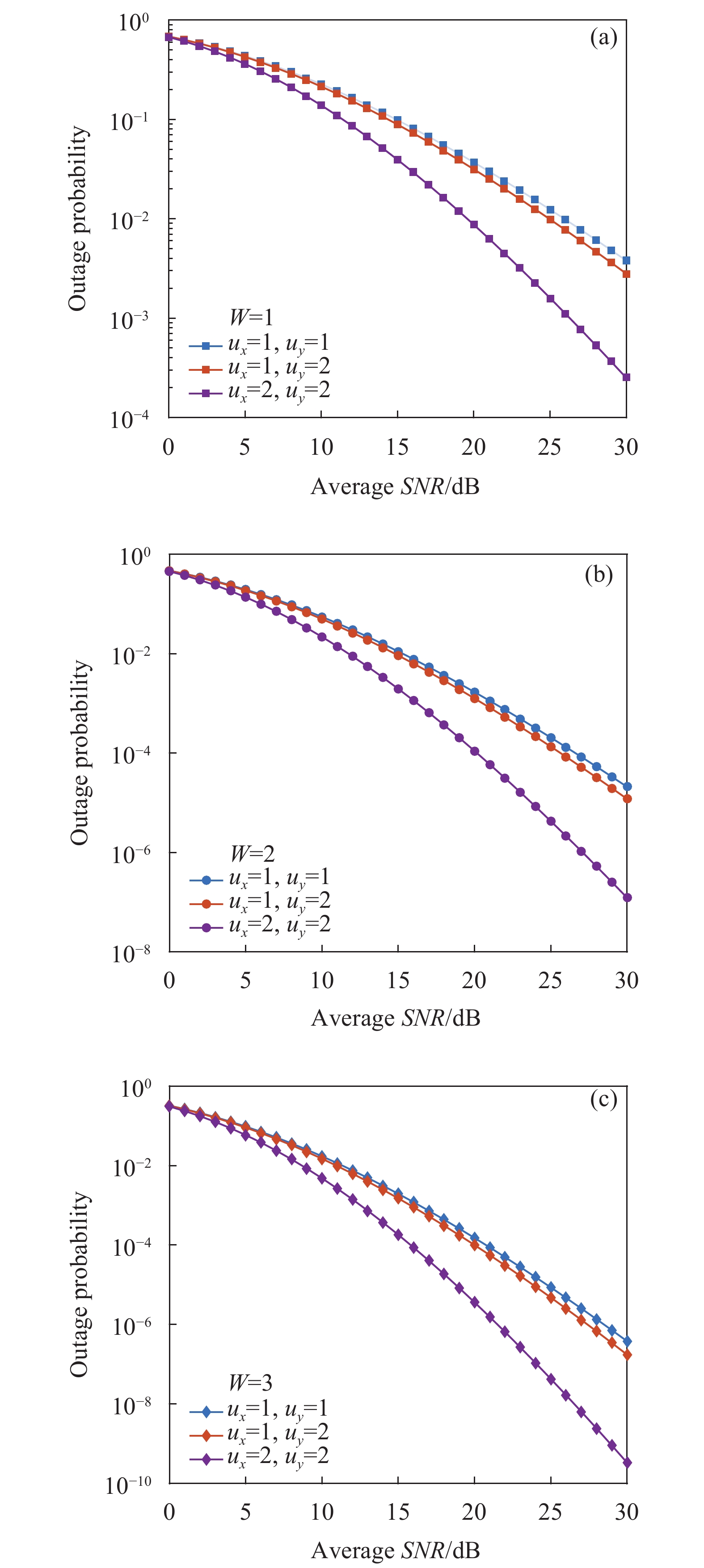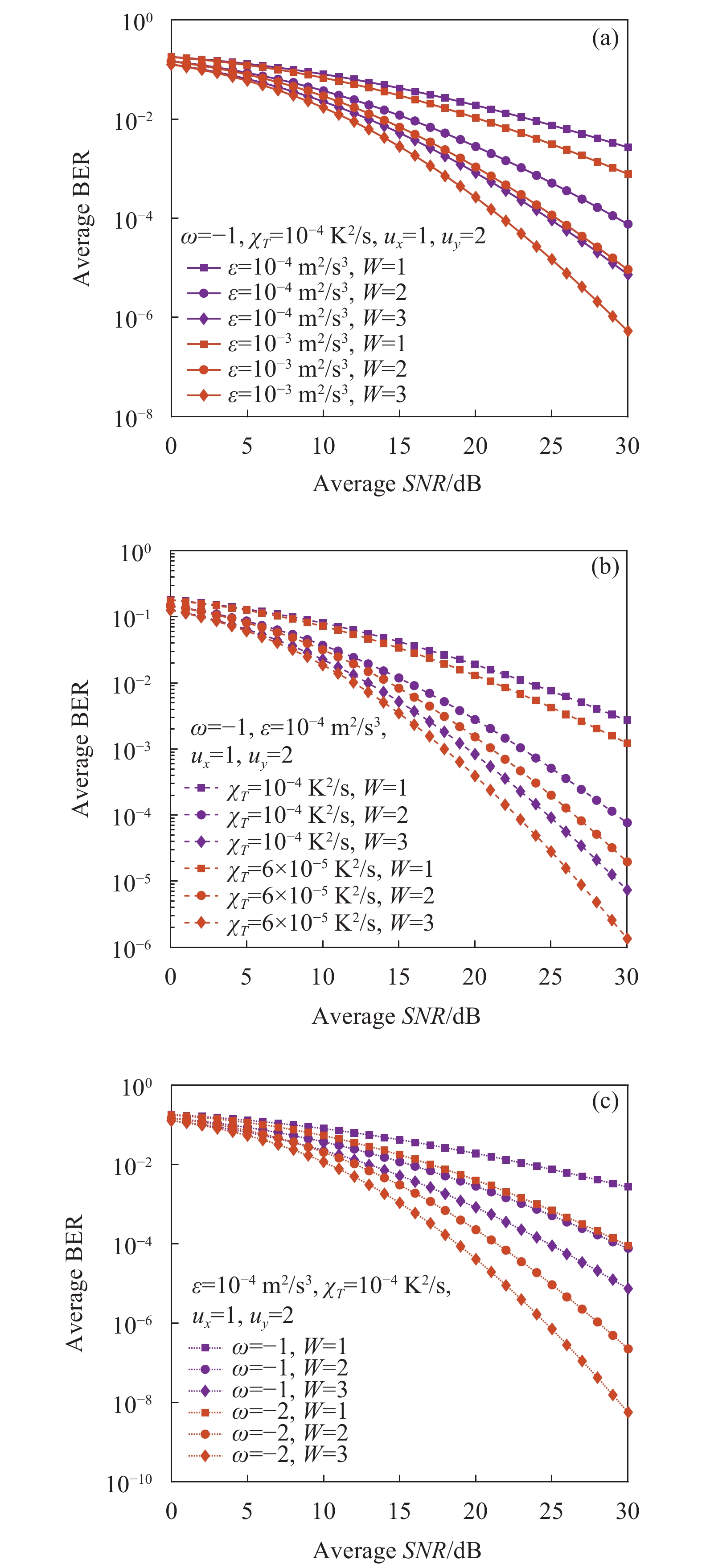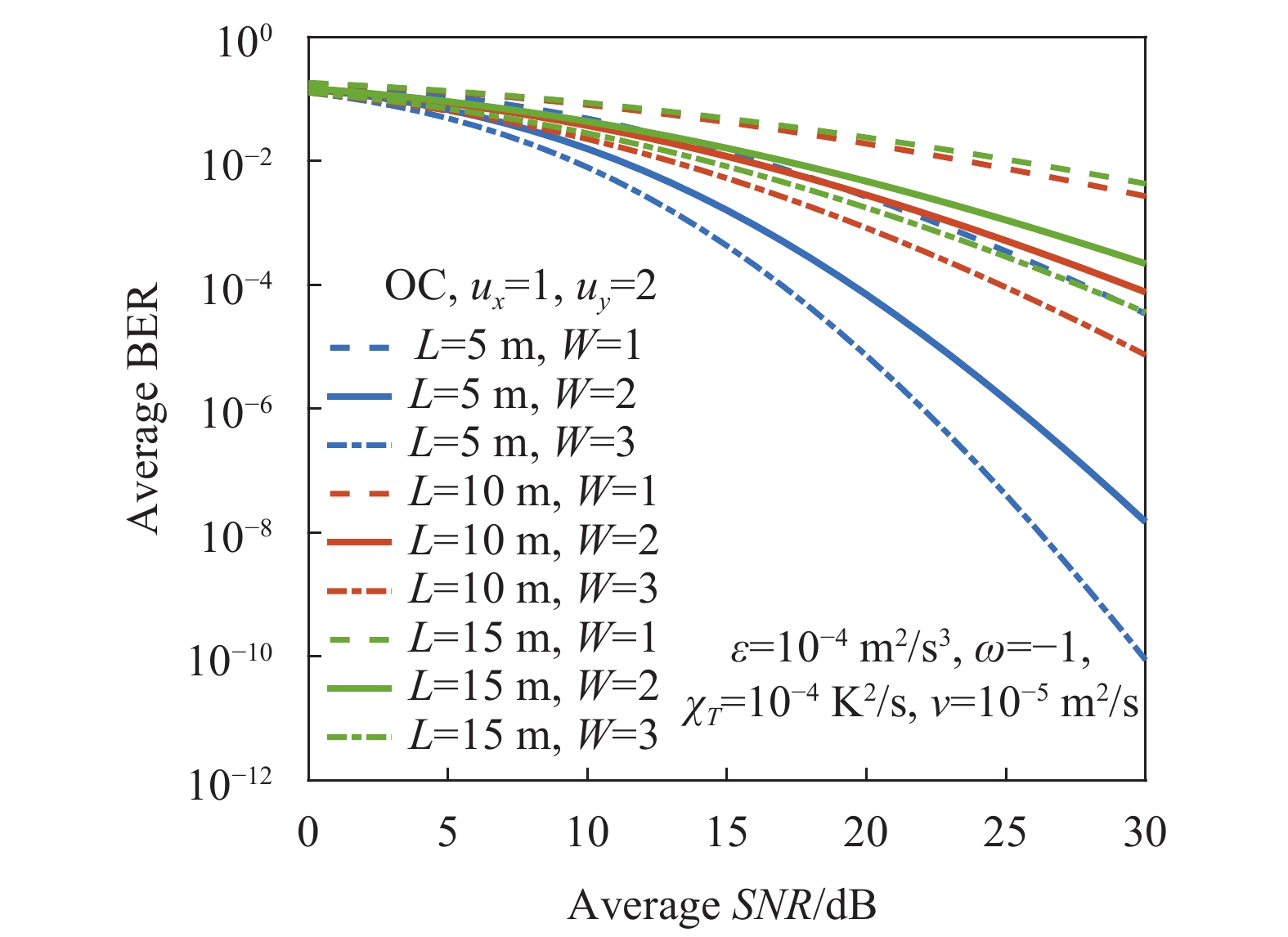-
水下通信技术[1]已成为探索海洋的主要方式之一。相较于传统水声通信与水下射频通信,水下无线光通信(Underwater wireless optical communication,UWOC)具有高速率、低延迟、大带宽及高安全性等优势,成为海洋资源勘探、水下无线传感网络以及潜水员、无人潜水器、潜艇和船舶之间通信的关键技术[2-3]。然而,水下无线光通信系统的传输性能受到复杂海水环境的严重影响,其中吸收、散射效应和海洋湍流是主要影响因素。海水中的溶解物、悬浮颗粒以及一些有机物质对光具有衰减作用,并且这种作用与光波长具有密切联系[4-5]。海洋湍流是由于海水受到温度梯度、盐度梯度变化引起的折射率随机变化,从而使UWOC系统接收端光强度闪烁[6-7],导致系统通信质量下降。
近年来,研究人员提出利用孔径平均[8-9]、分集技术[10-11]、信道编码[12-14]等技术来缓解湍流对于无线光通信系统的影响。其中分集技术包括波长分集、空间分集、时间分集等。波长分集技术利用不同工作波长发送相同数据,并由特定波长检测器接收[15]。空间分集技术使用多个发射机和接收机进行单波长的数据传输[16]。时间分集技术由单发射机-接收机在不同时隙内传输相同数据[17]。Dhaval Shah等人[18]基于K分布模型来模拟强大气湍流信道条件,采用波长分集技术推导出自由空间光通信(Free space optical,FSO)系统接收端不同信号组合的误码率表达式。Kanchan Sharma等人[19]研究分析了基于对数正态分布和Gamma-gamma分布信道模型的FSO系统在弱到强大气湍流强度下的波长分集和时间分集技术方案,并采用PPM-BPSK-SIM混合调制方式导出平均BER封闭表达式,结果表明合理使用分集技术对系统性能有所改善。Kostas P等人[20]基于对数正态分布的各向同性弱海洋湍流信道,采用空间分集技术和多脉冲位置调制技术推导出UWOC系统平均误码率近似解析表达式,仿真分析出不同设计参数下的系统性能。以上研究分别在大气湍流和各向同性海洋湍流条件下对具有分集技术的无线光通信系统性能进行分析,然而,在各向异性海洋湍流下采用波长分集技术的UWOC系统性能尚未报道。因此,文中考虑由吸收、散射效应引起的传输路径损耗和各向异性海洋湍流影响因素,对具有波长分集的水下无线光通信系统性能进行研究。
海洋湍流信道模型主要有对数正态湍流模型[21-22]、Gamma-gamma湍流模型[23-24]、负指数分布模型等,基于以上分布模型,文中采用存在传输路径损耗和Gamma-gamma分布的海洋湍流信道传输模型,根据海洋湍流参数和各向异性因子表示的等效结构参数,推导出使用波长分集技术的UWOC系统中断概率和平均误码率的封闭表达式。通过改变各向异性因子得到不同海洋湍流强度下具有波长分集技术的UWOC系统性能变化。当接收端使用最佳组合(Optimal combining,OC)和等增益组合(Equal gain combining,EGC)技术时,比较不同波长分集阶的UWOC系统平均误码率的变化,并仿真分析不同海洋湍流参数、传输距离对波长分集UWOC系统性能的影响。
-
如图1所示为具有波长分集的水下无线光通信系统框图,利用复合发射机在同一时刻发出不同工作波长的信号,经过存在传输路径损耗和海洋湍流效应的信道后,接收端的波长检测器接收相应波长信号。
文中采用强度调制/直接检测(IM/DD)与开关键控(OOK)调制的UWOC系统,假设复合发射机使用
$w = 1,2,\cdots,W$ 个不同工作波长同时发出相同数据信号,经过具有加性高斯白噪声(Additive white Gaussian noise,AWGN)的湍流信道模型,由$W$ 个特定波长检测器接收信号。此时,第$w$ 个接收机接收到的信号可表示为[25-26]:式中:
${y_w}$ 为接收机$w$ 接收到的信号;$h$ 为第$w$ 个信道的联合衰落状态;$\gamma $ 为接收机响应度;$x$ 为二进制传输信号;${n_0}$ 为均值为零且方差为${\sigma _n}^2$ 的独立加性高斯白噪声。考虑UWOC系统具有OOK调制信道衰落特性,接收到的瞬时电信噪比(Signal noise ratio,SNR)受信道状态
$h$ 的影响,表示为:式中:
${P_0}$ 为平均发射光功率;$\left\langle {SNR} \right\rangle $ 表示平均电信噪比。因此,可以表示为:式中:
$E[.]$ 表示归一化期望。 -
海水中含有复杂的杂质成分,导致光信号与杂质分子相互碰撞作用发生吸收、散射效应,引起接收端光脉冲展宽及延迟效应。通常用比尔-朗伯定律[1]描述海水信道对光信号的传输路径损耗
${h_l}$ ,可表示为:式中:
$L$ 为光信号在海水信道中的传输距离;$c(\lambda )$ 为总衰减系数。 -
海洋湍流引起的信道衰落被认为是随机过程,由Gamma-gamma分布描述弱、中到强湍流条件。发射端光信号经过湍流后,接收端辐照度分布遵循Gamma-gamma统计分布,其概率密度函数(Probability density function,PDF)表达式[27]为:
式中:
${{K}_\nu }(.)$ 为第二类$\nu $ 阶修正贝塞尔函数;$\varGamma (.)$ 为伽马函数。利用Meijer-G函数积分性质[28],公式(6)概率密度函数(PDF)可表示为:其中,
$\alpha $ 和$\;\beta $ 表示描述海洋湍流引起光束闪烁的尺度大小,$\alpha $ 描述大尺度参量,$\;\beta $ 描述小尺度参量,可表示为[23, 29]:式中:
$d = \sqrt {k{D^2}/4L} $ ,$k = 2\pi /\lambda $ 为波矢量,$D$ 为接收孔径大小,$L$ 为链路距离。平面波Rytov方差表示为${\sigma _R}^2 = 1.23C_n^2{k^{7/6}}{L^{11/6}}$ ,其中$C_n^2$ 是海洋湍流参数和各向异性因子表示的等效结构参数,由下式表示[24]:式中:
$z$ 为光束的传播方向;${\kappa _x}$ 和${\kappa _y}$ 分别表示在$x$ 与$y$ 方向的空间频率分量;$P({\textit{z}},{\kappa _x},{\kappa _y})$ 为$ik\exp ( - 0.5{(kL)^{ - 1}}\times $ $ i{\textit{z}}(L - {\textit{z}})({\kappa _x}^2 + \kappa {{}_y^2}))$ ;${\varPhi _n}(\kappa )$ 表示海洋湍流的折射率空间功率谱,其表达式为[7,30]:式中:
${u_x}$ 和${u_y}$ 分别表示海洋湍流中各向异性因子,$u$ 表示为${({u_x}{\kappa _x})^2} + {({u_y}{\kappa _y})^2}$ ,${u_x}{\rm{ = }}1,{u_y} = 1$ 表示各向同性湍流环境,$ {u}_{x}>1,{u}_{y}>1$ 表示各向异性海洋湍流环境;$\omega $ 表示温度与盐度对海洋湍流贡献的比值大小,取值范围为$[{\rm{ - }}5,0]$ ,当海洋湍流完全由温度梯度贡献时取值为−5,完全由盐度梯度贡献时取值为0;湍流单位动能耗散率$\varepsilon $ 取值范围为$[{10^{ - 10}}{{\rm{m}}^2}/{{\rm{s}}^3},{10^{ - 1}}{{\rm{m}}^2}/{{\rm{s}}^3}]$ ,当处于海洋深海时取值等于${10^{ - 10}}{{\rm{m}}^2}/{{\rm{s}}^3}$ ,处于海洋表层时取值等于${10^{ - 1}}{{\rm{m}}^2}/{{\rm{s}}^3}$ ;${\chi _T}$ 表示均方温度耗散率,取值范围从${10^{ - 10}}$ ~${10^{ - 2}}{{\rm K}^2}/{\rm{s}}$ ;$\nu $ 表示动力粘度系数,取值范围为$[0{{\rm {m}}^2}/{\rm{s}}, {10^{ - 5}}{{\rm{m}}^2}/{\rm{s}}]$ ;${A_T} = 1.863 \times {10^{ - 2}}$ ,${A_S} = 1.9 \times {10^{ - 4}}$ ,${A_{TS}} = 9.41 \times {10^{ - 3}}$ ,$\delta = 8.284\nu {\varepsilon ^{ - 1/3}}{u^{2/3}} + $ $ 12.978{\nu ^{3/2}}{\varepsilon ^{ - 1/2}}u$ 。 -
综合考虑1.2、1.3小节所介绍内容,光信号在海水中传输时,由于受到吸收、散射效应及海洋湍流影响,从而能量发生严重衰减。在波长分集UWOC系统中,信道联合衰减可表示为:
式中:
${h_l}$ 描述海水信道中由于吸收、散射引起的衰减效应;${h_t}$ 描述海洋湍流引起的信号衰落。因此,UWOC系统信道联合衰落状态$h$ 的PDF可表示为:将Gamma-gamma分布海洋湍流引起的衰落PDF代入公式(13),得到以下表达式:
-
中断概率是衡量水下无线光通信系统性能的重要指标之一,其定义为接收端瞬时信噪比小于临界检测阈值
$SN{R_{th}}$ 的概率,由下式表示为:根据1.4小节Gamma-gamma分布的PDF,推导出具有
$W$ 个不同信道的波长分集UWOC系统中断概率表达式。由于每个信道工作波长不同,假定$W$ 个信道彼此独立,得到对应$W$ 个信道的总中断概率表达式为:将公式(14)代入公式(16)得到具有波长分集的UWOC系统总中断概率表达式:
-
描述水下无线光通信系统性能的另一个重要指标是平均误码率。考虑AWGN情况下,采用IM/DD-OOK的UWOC系统平均误码率表达式为:
式中:
$P(.)$ 表示发送“0”或“1”的概率;$P(|)$ 表示条件概率。根据对称性得到$P(0) = P(1) = 0.5$ ,$P(e|0) = P(e|1)$ 。 -
对于具有波长分集的UWOC系统,采用复合发射机发射出
$W$ 个波长信号对应多个特定波长检测机接收,假定每个信道链路发送相同的“0”和“1”概率。在最佳组合[18](OC)接收机方案中,根据信号强度对不同信道的信号副本进行同相加权得到具有波长分集的UWOC系统平均BER表达式为:
式中:
${h_w}$ 表示不同信道衰落状态;$Q(.)$ 表示高斯$Q$ 函数,根据其性质近似等于$Q(x) \approx 1/12\exp ( - {x^2}/2) + $ $ 1/4\exp ( - 2{x^2}/3)$ ,因此公式(19)可化简为:将公式(14)代入公式(20),得到:
根据Meijer-G函数指数函数性质,
$\exp (.)$ 可表示为:利用公式(22)代入公式(21)得到波长分集UWOC系统的平均BER简化表达式为:
-
在具有波长分集的UWOC系统接收端的不同组合方案中,等增益组合[31](EGC)是将不同信道的接收端处得到的信号副本适当比例合并。与最佳组合(OC)相比,在实际情况中等增益组合(EGC)具有较低的链路复杂度。根据3.1小节OC组合平均BER推导过程,同理得到等增益组合(EGC)的平均BER表达式为:
对公式(24)化简得到EGC最终平均BER表达式为:
-
根据第2、3小节得到的中断概率与平均误码率封闭表达式,本小节分析了基于波长分集的水下无线光通信系统受到传输路径损耗和各向异性海洋湍流影响下的性能变化。由水下无线光通信系统信道传输衰减特性可知[4,32],不同海水类型对光的衰减作用有所差异,图2所示为近海水质中不同波长光信号总衰减系数[33-34],在550~590 nm之间的光波衰减系数较小,其中波长为570 nm的光信号在传输过程中受到的吸收、散射效应最小。因此,文中选取受近海水质衰减影响较小的560、570、580 nm光波信号应用于UWOC系统波长分集方案。波长分集可由分集阶
$w{\rm{ = }}1,2,\cdots,W$ 决定,无波长分集$ (W=1)$ 采用570 nm波长工作,2阶分集$ (W\rm{=}2)$ 工作波长为570 nm和560 nm,具有3阶分集$ (W=3)$ 时工作波长为570、560、580 nm。仿真中所用到的参数如表1所示。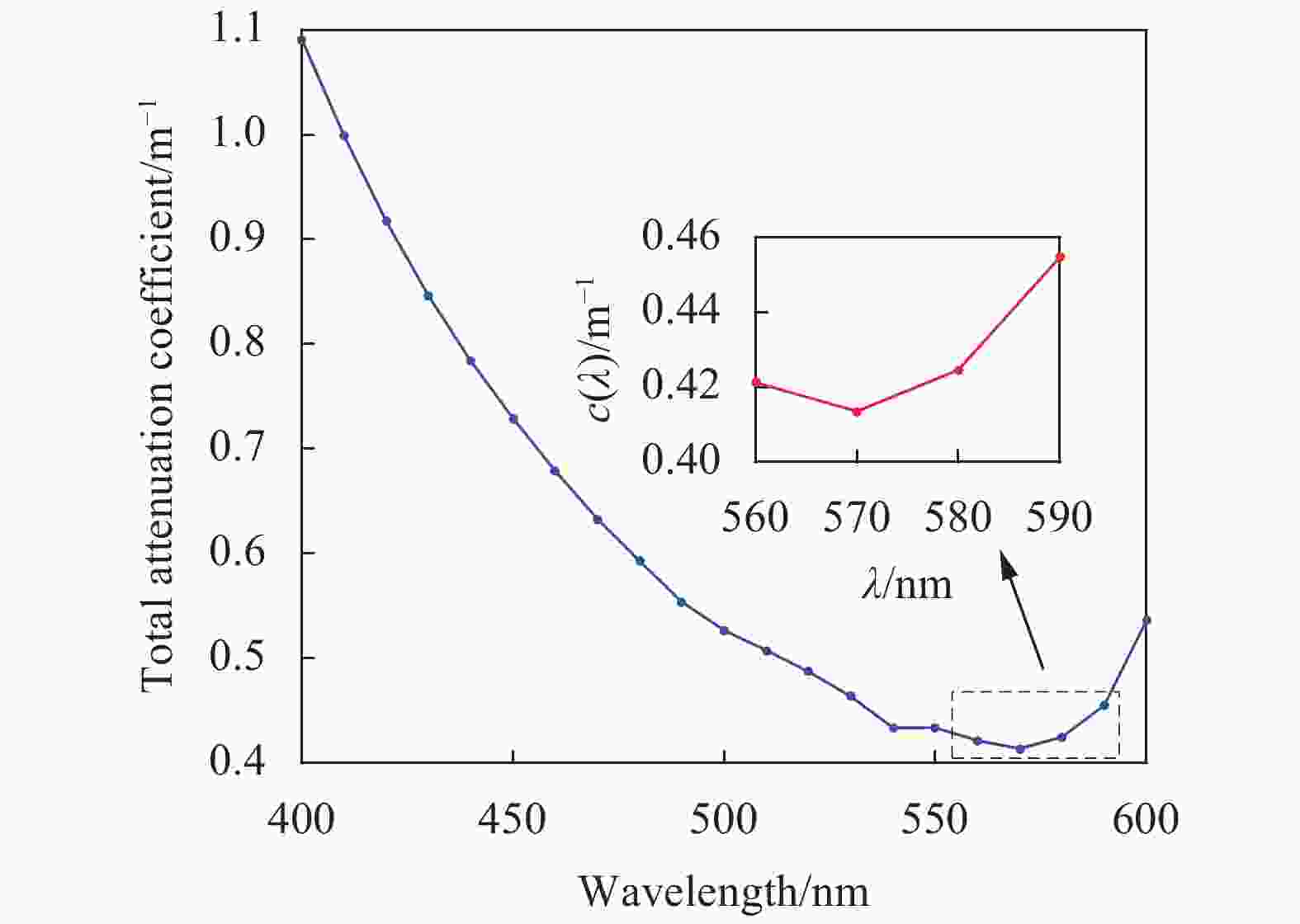
Figure 2. Total attenuation coefficient of optical signals of different wavelengths in coastal ocean
Coefficient Value Ratio of temperature and salinity contribution to ocean turbulence, $\omega $ ${\rm{ - }}1$ Kinetic energy dissipation rate, $\varepsilon /{{\rm{m}}^2} \cdot {{\rm{s}}^{{\rm{ - }}3}}$ ${10^{{\rm{ - 4}}}}$ Mean square temperature dissipation rate, ${\chi _T}/{{\rm K}^2} \cdot {{\rm{s}}^{{\rm{ - }}1}}$ ${10^{{\rm{ - 4}}}}$ Dynamic viscosity coefficient, $\nu /{{\rm{m}}^2} \cdot {{\rm{s}}^{{\rm{ - }}1}}$ ${10^{{\rm{ - 5}}}}$ Receiver diameter, $D/{\rm{mm}}$ $1$ Transmission distance, $L/{\rm{m}}$ $10$ Table 1. Simulation parameters
接收机对三种波长光信号的接收响应度不同。仿真中设置560、570、580 nm波长光信号对应的光子检测效率
$\eta $ 分别为32%、30%、29%。由公式$\gamma {\rm{ = }}\dfrac{{M\eta e}}{{hv}}$ 可得到接收机对不同光波长的响应度,其中$e$ 表示电子电量,$h$ 表示普朗克常数,$v$ 表示光频,$M$ 表示雪崩光电二极管倍增系数。结合三种波长光信号在近海水质中的衰减效应以及接收机的响应度,可以计算得到不同工作波长之间的平均信噪比关系。波长为570 nm的光信号在近海水质中传输平均信噪比为$\left\langle {SN{R_1}} \right\rangle $ ,当传输距离为10 m时,560 nm和580 nm的波长信号平均信噪比$\left\langle {SN{R_2}} \right\rangle $ 、$\left\langle {SN{R_3}} \right\rangle $ 分别为$0.95\left\langle {SN{R_1}} \right\rangle $ 、$0.{\rm{78}} $ $ \left\langle {SN{R_1}} \right\rangle $ 。当传输距离等于5 m时,560 nm和580 nm的波长光信号平均信噪比关系分别为${\rm{1}}{\rm{.02}}\left\langle {SN{R_1}} \right\rangle $ 、$0.{\rm{87}}\left\langle {SN{R_1}} \right\rangle $ ;在15 m的传输距离下,560 nm和580 nm的波长光信号平均信噪比关系分别为$0.{\rm{9}}\left\langle {SN{R_1}} \right\rangle $ 、$0.{\rm{7}}\left\langle {SN{R_1}} \right\rangle $ 。在进行波长分集UWOC系统性能仿真时,每个图中平均SNR表示采用570 nm波长光信号在无波长分集系统中传输的平均信噪比$\left\langle {SN{R_1}} \right\rangle $ 。当$W{\rm{ = 2}}$ 时,570 nm和560 nm的光信号在海水信道中传输受到的衰减效应有所差别,此时得到系统中断概率与平均误码率中包含经过两个不同衰减的平均信噪比。同样地,在$W{\rm{ = 3}}$ 的系统中,海水信道对570、560、580 nm波长光信号的衰减效应不同,传输过程中分别对应三个平均信噪比,最终得到3阶波长分集下UWOC系统性能的变化。根据公式(10)获得各向异性海洋湍流等效结构参数,图3(a)~(c)绘制了在不同各向异性因子下波长分集UWOC系统的中断概率变化,表2给出了平均信噪比30 dB时不同各向异性因子下无波长分集与2、3阶波长分集UWOC系统中断概率的具体数值。随着各向异性因子
${u_x}$ 、${u_y}$ 分别在$x$ 和$y$ 方向上同时增加,无波长分集和2、3阶波长分集的UWOC系统中断概率明显降低。比如在$W{\rm{ = }}3$ 的波长分集UWOC系统中,增加各向异性因子${u_x}$ 和${u_y}$ ,系统中断概率从$3.819 \times {10^{{\rm{ - 7}}}}$ 减小至$3.347 \times {10^{{\rm{ - 10}}}}$ 。这是因为各向异性因子增大,海洋湍流内部由于不对称性加剧导致结构密度降低,相邻涡流单元层碰撞减少,使湍流折射率变化起伏降低,海洋湍流强度减小,导致闪烁效应减弱,使UWOC系统具有了较小的中断概率。当各向异性因子相等时,相较于无波长分集UWOC系统,使用波长分集的系统中断概率更低,且$W{\rm{ = }}3$ 的波长分集UWOC系统比$W{\rm{ = 2}}$ 的UWOC系统性能更好。比如在各向异性因子${u_x} = 1,{u_y} = 2$ 时,无波长分集UWOC系统中断概率为$2.798 \times {10^{{\rm{ - 3}}}}$ ,2、3阶波长分集UWOC系统中断概率分别为$1.199 \times {10^{{\rm{ - 5}}}}$ 、$1.{\rm{749}} \times $ $ {10^{{\rm{ - 7}}}}$ 。
Figure 3. Outage probability performance of wavelength diversity UWOC system under different anisotropic factors. (a) No wavelength diversity; (b) Second-order wavelength diversity; (c) Third-order wavelength diversity,
$L{\rm{ = }}10\;{\rm{m}}$ Wavelength diversity ${u_x} = 1,{u_y} = 1$ ${u_x} = 1,{u_y} = 2$ ${u_x} = 2,{u_y} = 2$ $W{\rm{ = 1}}$ $3.{\rm{792}} \times {10^{{\rm{ - 3}}}}$ $2.798 \times {10^{{\rm{ - 3}}}}$ $2.{\rm{499}} \times {10^{{\rm{ - 4}}}}$ $W{\rm{ = 2}}$ $2.097 \times {10^{{\rm{ - 5}}}}$ $1.199 \times {10^{{\rm{ - 5}}}}$ $1.{\rm{228}} \times {10^{{\rm{ - 7}}}}$ $W{\rm{ = 3}}$ $3.819 \times {10^{{\rm{ - 7}}}}$ $1.{\rm{749}} \times {10^{{\rm{ - 7}}}}$ $3.347 \times {10^{{\rm{ - 10}}}}$ Table 2. Outage probability of wavelength diversity UWOC system under different anisotropy factors
图4给出在10 m的传输距离下接收端使用OC和EGC技术的波长分集UWOC系统平均BER变化。当各向异性因子
${u_x} = 1,{u_y} = 2$ ,平均信噪比为30 dB时,2阶波长分集UWOC系统接收端使用OC和EGC的平均BER分别为$7.634 \times {10^{{\rm{ - 5}}}}$ 、$1.355 \times $ $ {10^{{\rm{ - 4}}}}$ ,3阶波长分集UWOC系统接收端使用OC和EGC的平均BER分别等于$7.375 \times {10^{{\rm{ - 6}}}}$ 、$2.707 \times {10^{{\rm{ - 5}}}}$ 。根据数值结果表明,相同阶数的波长分集UWOC系统接收端使用OC技术比EGC技术得到的平均误码率更低。
Figure 4. Comparison of the average BER performance of the UWOC system without wavelength diversity using OC and EGC technology under different anisotropic factors,
$L{\rm{ = }}10\;{\rm{m}}$ 图5和图6更加详细地表明了使用波长分集的UWOC系统在不同海洋湍流参数下的性能变化。选取各向异性因子
${u_x} = 1,{u_y} = 2$ 时,不同的动能耗散率$\varepsilon $ 、均方温度耗散率${\chi _T}$ 、温度与盐度对海洋湍流贡献比值$\omega $ 对波长分集UWOC系统中断概率和平均误码率的影响。改变每个图所示变量,给定其余海洋湍流参数。由图5(a)和图6(a)可知,随着湍流中动能耗散率的增加,波长分集UWOC系统的中断概率和平均误码率逐渐降低。这是因为动能耗散率决定湍流中的能量转化,单位流体质量的动能耗散率越大,湍流中转化为分子热能的能量越快,海洋湍流强度越弱,此时系统性能受到的影响减小。从图5(b)和图6(b)中可以看出,当均方温度耗散率减小时,波长分集UWOC系统中断概率与平均误码率降低。这是因为均方温度耗散率描述湍流对流体温度场的影响,当均方温度耗散率减小时,分子热传导作用对温度的波动影响变小,系统性能受湍流影响减弱。从图5(c)和图6(c)中可以发现,波长分集UWOC系统的中断概率与平均误码率随着温度与盐度对海洋湍流贡献比值$\omega $ 的增大而增加。$\omega $ 越大,表明盐度引起的海洋湍流的贡献越大,湍流强度变大,系统的通信系统性能恶化。
Figure 5. Outage probability performance of wavelength diversity UWOC system under different ocean turbulence parameters, (a) kinetic energy dissipation rate
$\varepsilon $ , (b) mean square temperature dissipation rate${\chi _T}$ , (c) the ratio of temperature and salinity contribution to ocean turbulence$\omega $ ,$L{\rm{ = }}10\;{\rm{m}}$ 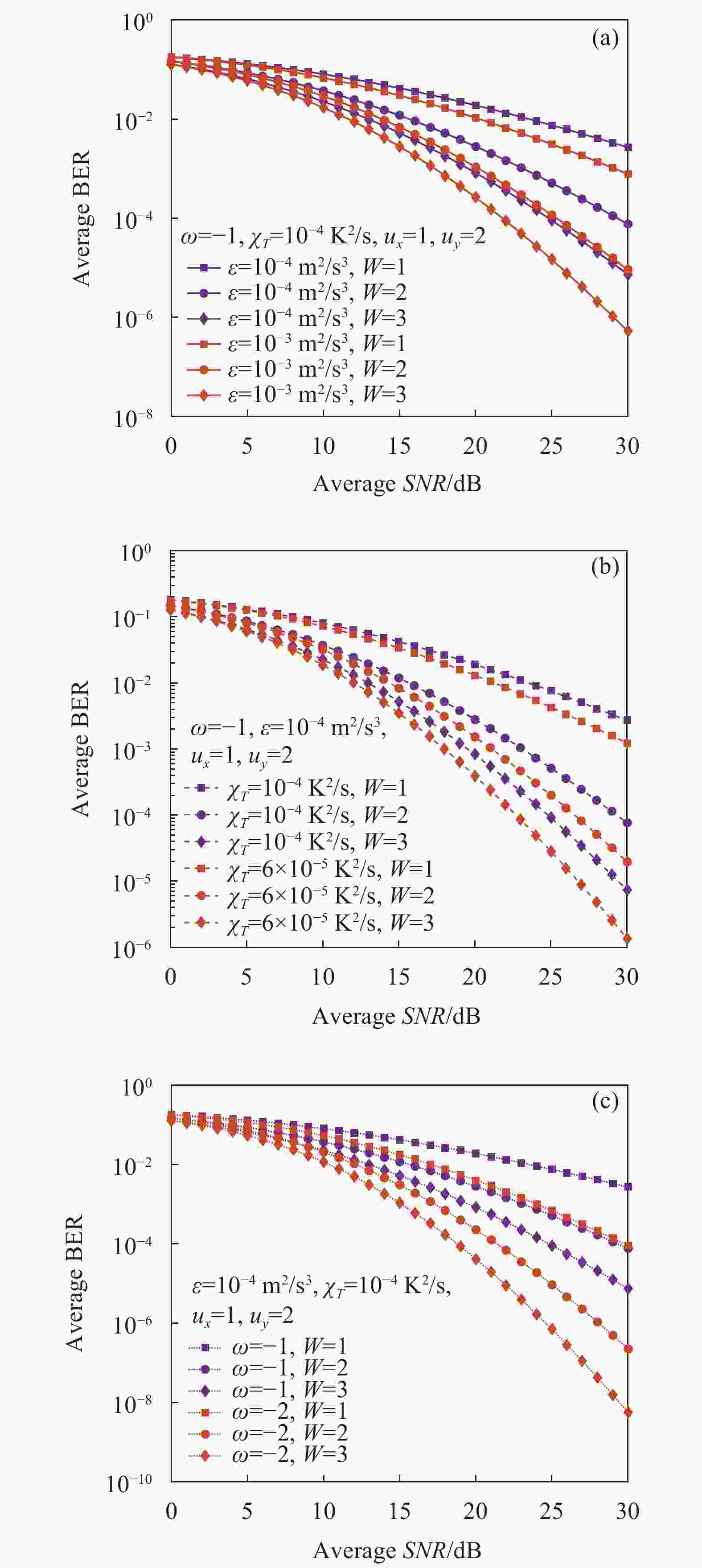
Figure 6. Average BER performance of wavelength diversity UWOC system under different ocean turbulence parameters, (a) kinetic energy dissipation rate
$\varepsilon $ , (b) mean square temperature dissipation rate${\chi _T}$ , (c) the ratio of temperature and salinity contribution to ocean turbulence$\omega $ ,$L{\rm{ = }}10\;{\rm{m}}$ 图7给出在近海水质和各向异性因子
${u_x} = 1, $ $ {u_y} = 2$ 的海洋湍流条件下,波长分集UWOC系统经过不同传输距离时的平均BER变化曲线,表3给出了平均信噪比30 dB时不同传输距离下无波长分集与2、3阶波长分集UWOC系统平均BER的具体数值。当传输距离从5 m增加到15 m时,无波长分集UWOC系统平均BER从$3.{\rm{42}} \times {10^{{\rm{ - 5}}}}$ 变为$4.308 \times {10^{{\rm{ - 3}}}}$ ;2阶波长分集UWOC系统平均BER从$1.481 \times {10^{{\rm{ - 8}}}}$ 变为$2.198 \times $ $ {10^{{\rm{ - 4}}}}$ ;同样地,3阶波长分集UWOC系统平均BER从$8.761 \times {10^{{\rm{ - 11}}}}$ 变为$3.604 \times {10^{{\rm{ - 5}}}}$ 。随着传输距离的增加,波长分集UWOC系统平均误码率变大。这是因为增加传输距离,不同波长光信号传输时受到的海水衰减和海洋湍流效应影响逐渐加剧,导致UWOC系统性能下降。当处于同一传输距离时,使用波长分集的UWOC系统比无波长分集系统性能更好,并且3阶波长分集比2阶波长分集的UWOC系统平均误码率明显改善。比如当传输距离等于5 m时,无波长分集UWOC系统平均BER为$3.{\rm{42}} \times {10^{{\rm{ - 5}}}}$ ,而$W{\rm{ = 2}}$ 和$W{\rm{ = 3}}$ 的波长分集UWOC系统平均BER分别为$1.481 \times $ $ {10^{{\rm{ - 8}}}}$ 、$8.761 \times {10^{{\rm{ - 11}}}}$ 。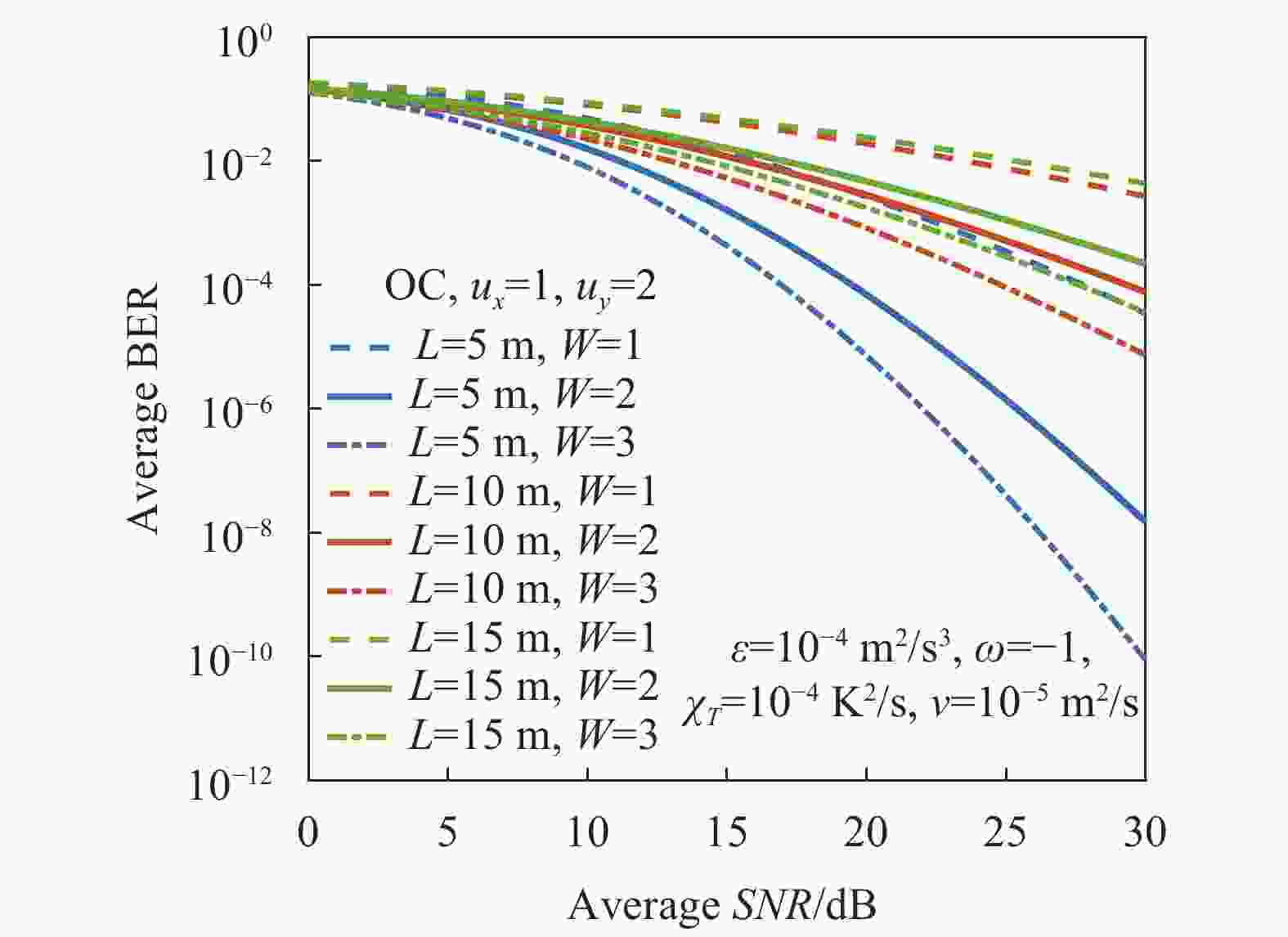
Figure 7. Average BER performance of wavelength diversity UWOC system using OC technology under different transmission distances
Wavelength diversity $L{\rm{ = }}5\;{\rm{m}}$ $L{\rm{ = 10\;m}}$ $L{\rm{ = 1}}5\;{\rm{m}}$ $W{\rm{ = 1}}$ $3.{\rm{42}} \times {10^{{\rm{ - 5}}}}$ $2.7 \times {10^{{\rm{ - 3}}}}$ $4.308 \times {10^{{\rm{ - 3}}}}$ $W{\rm{ = 2}}$ $1.481 \times {10^{{\rm{ - 8}}}}$ $7.634 \times {10^{{\rm{ - 5}}}}$ $2.198 \times {10^{{\rm{ - 4}}}}$ $W{\rm{ = 3}}$ $8.761 \times {10^{{\rm{ - 11}}}}$ $7.{\rm{375}} \times {10^{{\rm{ - 6}}}}$ $3.604 \times {10^{{\rm{ - 5}}}}$ Table 3. Average BER of wavelength diversity UWOC system using OC technology under different transmission distances
-
文中研究了存在传输路径损耗和Gamma-gamma分布海洋湍流信道模型,利用海洋湍流参数和各向异性因子表示的等效结构参数,根据Meijer-G函数推导出波长分集水下无线光通信系统中断概率与平均误码率封闭表达式。使用以上表达式进行数值仿真,分析在近海水质和不同各向异性因子的海洋湍流条件下,波长分集UWOC系统的中断概率性能,比较接收端使用OC与EGC技术的系统平均误码率,以及在不同海洋湍流参数、传输距离下波长分集无线光通信系统性能。结果表明:考虑光信号在海水信道中的传输路径损耗,随着各向异性因子的增加,海洋湍流强度逐渐减弱,相较于无波长分集UWOC系统,使用波长分集的UWOC系统中断概率与平均误码率更低,并且处于相同阶数的波长分集下,系统接收端使用OC技术比EGC技术具有更低的平均误码率。
Performance analysis of wavelength diversity wireless optical communication system in ocean turbulence
doi: 10.3788/IRLA20210131
- Received Date: 2021-07-10
- Rev Recd Date: 2021-09-25
- Publish Date: 2021-12-31
-
Key words:
- underwater wireless optical communication /
- ocean turbulence /
- wavelength diversity /
- Gamma-gamma distribution /
- outage probability /
- average bit error rate
Abstract: Due to seawater absorption, scattering attenuation and ocean turbulence effects, the optical signal at the receiving end of the underwater wireless optical communication (UWOC) system will flicker. The flickering signal will result in a decrease in the transmission performance of the UWOC system. Based on the Gamma-gamma distribution of the ocean turbulence channel model, according to the equivalent structural parameters represented by ocean turbulence parameters and anisotropy factors, the closed expressions of the outage probability (OP) and the average bit error rate (BER) of the wavelength diversity UWOC system were derived. With the increase of the anisotropy factor, the changes in the outage probability and the average bit error rate of UWOC system with different wavelength diversity orders were analyzed. The average bit error rate difference of the UWOC system between the optimal combining (OC) and the equal gain combining (EGC) used at the receiving end technology were compared, and the influence of different ocean turbulence parameters and transmission distances on the performance of the wavelength diversity UWOC system was simulated. The numerical results show that the ocean turbulence effect on the UWOC system gradually weakens with the increase of the anisotropy factor. The UWOC system with wavelength diversity technology has significantly improved the outage probability and the average bit error rate than the UWOC system without wavelength diversity technology.



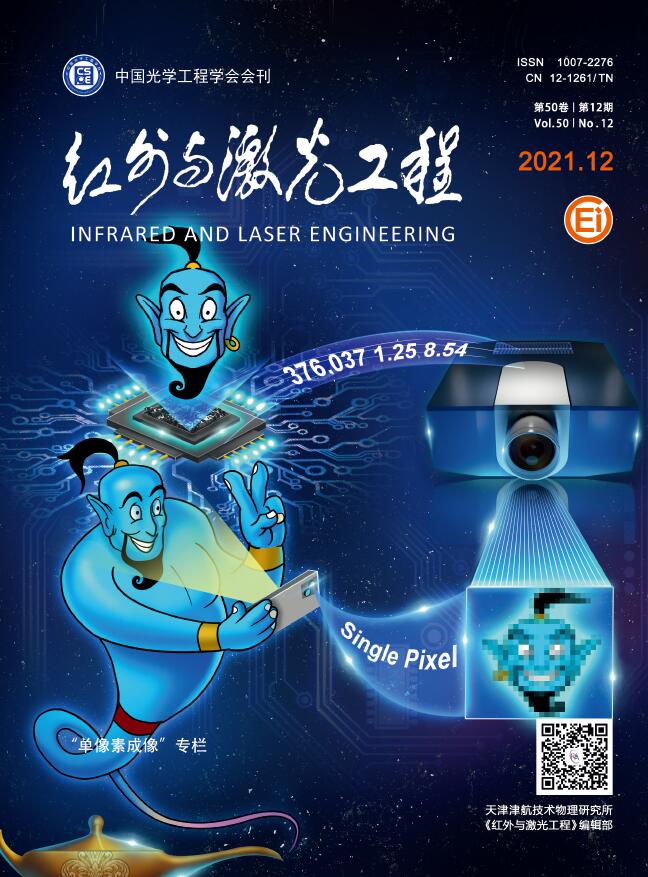




















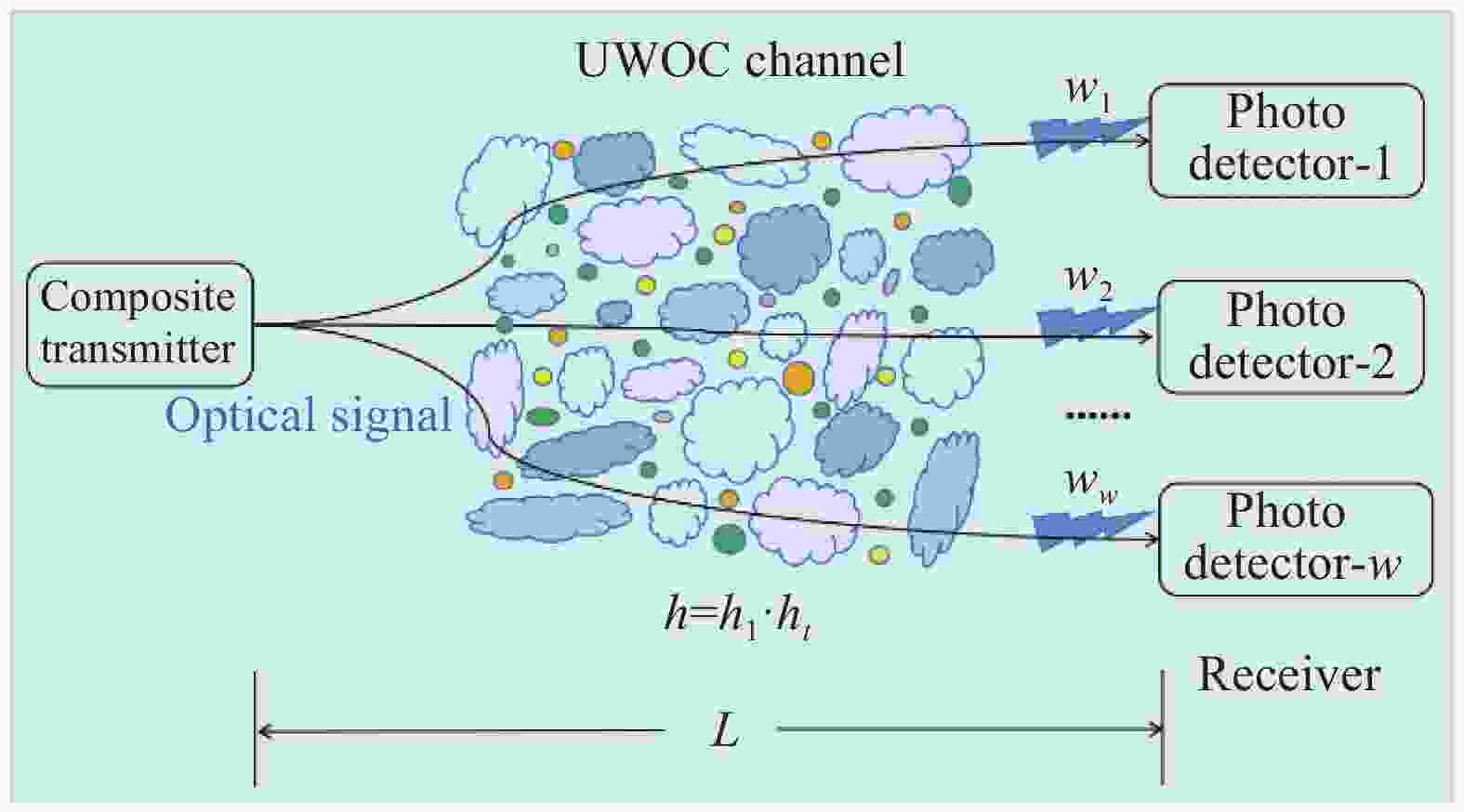














































































































































 DownLoad:
DownLoad:
